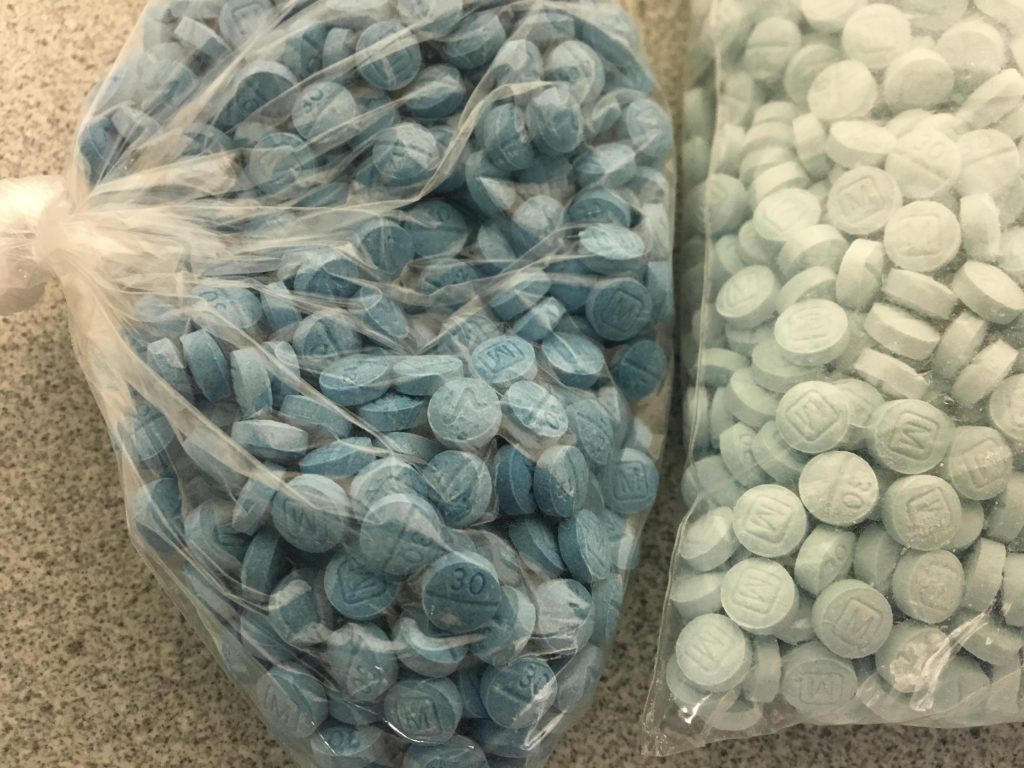A Map of County’s Overdose Deaths
78% of deaths last year involved fentanyl. But use of new drug, Xylazine, rising.
More than homicides or car accidents, communities across Milwaukee County have endured worsening waves of drug overdose deaths. Last year 644 people died of a drug-related cause in the county, eclipsing the 544 lives lost in 2020. Over the last decade, drug overdose deaths have steadily increased with records set year after year. It’s a crisis which is becoming more complex and more lethal, and continues to evolve.
A seemingly self-diversifying supply of fentanyl analogs drives the death toll. From Jan. 1 to July 24 of this year, the Milwaukee County Medical Examiner’s Office (MCMEO) documented 340 drug-related deaths. Of those deaths 271, or roughly 80%, involved some form of fentanyl. Another 100 deaths are still under investigation. On Aug. 18, MCMEO tweeted that over the weekend the office conducted six new probable overdose investigations, as well as four homicides, two vehicle fatalities, and one suicide.
In Fond du Lac County, for instance, 17 of the 19 drug overdose deaths involved fentanyl in 2021. Dr. Adam Covach, chief medical examiner for the county, also listed several fentanyl analogs detected among the dead. Those included para-fluro fentanyl and acetyl fentanyl, which studies have shown to be as much as 15 times more potent than heroin.
“As we continue to work to promote mental health, reduce harm, and increase support for those struggling with substance use disorders, we can’t ignore the greater risks people face by not knowing what is included in the drugs they are taking,” said DHS Secretary-designee Karen Timberlake. “This is a public health crisis, and it’s necessary to sound the alarm to prevent unnecessary deaths.”
To help visualize the crisis, the Wisconsin Examiner created the map below. Each point on the map, color-coordinated according to cause of death, was once a living human being. By selecting the menu on the top-left side, readers can also choose whether to see all the deaths, or just those involving fentanyl. In order to show where deaths are clustering naturally, the map does not include those who died inside of local hospitals. The Wisconsin Examiner has previously mapped drug-related deaths for 2018, 2019, and 2020.
Key: Black– mainly fentanyl | Purple – fentanyl with another drug like MDMA or oxycodone, but no heroin/cocaine | Brown – a combination of at least 3-4 drugs, at least one being fentanyl | Violet– mainly heroin, cocaine, fentanyl |Yellow – cocaine and heroin, no fentanyl | Blue – mainly heroin | Red – mainly heroin and fentanyl mainly | Green– mainly cocaine | Red Purple – mainly cocaine and fentanyl |Orange – meth is listed, no cocaine, heroin or fentanyl | Dark Blue – meth is listed with cocaine, heroin or fentanyl | Gray– other | House Icon- An existing Community Medical Services Clinic
The extinction of heroin, arrival of benzo dope, and spread of tainted coke
About 78% of Milwaukee County’s 644 drug-related deaths last year involved some form of fentanyl. The drug, up to 10,000 times more potent than morphine, has thoroughly infiltrated illicit drug markets. Its prevalence means that deaths from heroin alone have all but disappeared from Milwaukee County. During 2021, just two deaths were solely attributed to heroin appeared on the overdose map, though hospital deaths weren’t included on the map. A startling rise in deaths caused by cocaine mixed with fentanyl has also persisted. Cocaine-fentanyl deaths occurred from Milwaukee’s North Side, to the East Side, to the South Side, over toward West Allis, and in Wauwatosa.
In late June, Sara Schreiber, forensic technical director in the county medical examiner’s office, said that roughly 80% of the area’s cocaine deaths involve fentanyl. Schreiber told the Wisconsin Examiner that the office is conducting research, “to see if we can determine what that really looks like in order to help inform, and educate, around the matter.”
Fentanyl has also made deaths from drugs like methamphetamine more common. From 2020 to 2021, deaths involving methamphetamine in Milwaukee County increased from just four to 14. The spread of black market fentanyl is due to the drug’s high potency. It allows for drugs like heroin, methamphetamine, and cocaine to be cut with fentanyl at various points along the supply line, maximizing profits.
A new drug, Xylazine, has also settled into the scene. Used for sedating and relaxing large animals like horses and cattle, the tranquilizer is becoming more common in urban areas. In May, Vice News published a documentary on drug mixtures with Xylazine. On the street, it’s called “benzo dope” or “tranq.” Xylazine was found in just four deaths in 2020, and just once in 2019. In 2021, however, it was found in 40 cases. Fentanyl was also detected in many deaths involving Xylazine. As of July 24 of this year, Milwaukee County has seen 32 deaths involving Xylazine.
The Vice documentary mentioned “benzo dope” could cause necrosis, or dead tissue, in body parts. Schreiber, however, told Wisconsin Examiner that Milwaukee’s cases lacked those sorts of wounds.
“There’s two thoughts in my mind about this,” Schreiber said. “It’s not science-based but it’s a thought that I have: One would be route of administration, whether or not that product is consumed orally, versus injected, versus taking it some other route of administration, and how that could affect the body and therefore, present these wounds.”
Schreiber explained that the wounds reported with Xylazine use occurred in a population which injected the drug. “That begs another question, research-wise. Where are we finding the Xylazine?” A toxic effect physically from mixing Xylazine with other drugs is another possibility.
Counterfeit pills are adding a new dimension of danger for street purchases, where someone seeking a specific pill may get a fentanyl-laced copy. “There are some opioids that are being mimicked as well. The Oxycodone tablets are being mimicked, especially the box 30’s,” Schreiber said. Doppelgangers such as these are nigh impossible to tell apart from a legit pill.
Groups like the Street Angels, focusing on Milwaukee’s unhoused population, also encounter the tragic traces of addiction. Dan Grelliger, data administrator and a board member of Street Angels said the addiction crisis has become more noticeable.
“I’ve been doing outreach since 2015, so that’s six years, at least once a week, sometimes several times per week,” Grelliger said. “And I’ve never really encountered anybody in the process of shooting up during that time, and it happened the first time for me like a month ago. And since that time, it’s happened like three or four times. So in the last month, I’ve had three or four experiences where I’ve come up on somebody, and they’re in the process of shooting up.” According to the Medical Examiner’s data, 43 drug-related deaths happened during June, when Grelliger spoke with Wisconsin Examiner. Though keep in mind that 100 deaths are still under investigation.
Grelliger explained that encountering someone using doesn’t always happen “the way you expect.” He recalled, “a young lady was like, leaning over and shooting up in her foot. I thought she was playing with her phone before I understood what she was doing. I saw a lady with her pants down that was shooting up in her thigh. It’s just … it’s disturbing.” The Street Angels distribute supplies from food to clothing, to needles and narcan — which can help revive a person who’s overdosed. “Even that’s kind of tricky,” said Grelliger, noting that Street Angels has had to strategize how best to do harm reduction.
While tools like narcan are available, the potency and prevalence of fentanyl analogs makes saving lives more difficult. During a DHS briefing on Aug. 17, Dr. Jasmine Zapata, chief medical officer of the DHS Bureau of Community Health Promotion, outlined the issue. “Because fentanyl is so potent,” she said, “in many situations, individuals will require more than one dose of narcan.” Not only may someone need more than one dose, but they’ll also likely need medical attention once they’re revived. It’s also a good idea to carry narcan even if you’re doing something you wouldn’t expect fentanyl to be in. Cocaine, counterfeit pills, MDMA (sometimes called Molly), or methamphetamine are all prime examples.
As things play out in state and local government
One of the biggest moves made by the state government occurred in March, with the legalization of fentanyl testing strips. In the past, the strips were considered drug paraphernalia which could carry a felony charge. Once bipartisan legislation legalized the strips, Milwaukee County started off with a supply of 1,600 strips. Besides county outreach staff, emergency first responders, and treatment centers, grassroots community groups have also received testing strips.
For Rep. Sylvia Ortiz-Velez (D-Milwaukee), legalizing the strips was a small victory in a larger struggle. Ortiz-Velez said she has seen drug-related deaths soar in her legislative district, which covers Milwaukee’s largely Latino South Side.
“Five years ago we were 5% in Milwaukee County, now it’s over 80%,” she said, referencing the amount of fentanyl-related deaths. Those deaths and the grieving parents, compelled Ortiz-Velez to action. “It’s just so sad,” Ortiz-Velez told the Wisconsin Examiner. “If it doesn’t break your heart, you can’t be human.”
Ortiz-Velez first heard of the testing strips during a community clean up event. She worked with Rep. Jesse James (R-Altoona), who chaired the state’s Committee on Substance Abuse and Prevention, to craft the bill which passed with bipartisan support. Ortiz-Velez said many legislators on both sides of the aisle were surprised that the strips were illegal.
Milwaukee-area treatment centers are also struggling to keep up. By 2019, fatal overdoses in West Allis had stretched across the community from east to west. Once Community Medical Services, a medication-assisted treatment center, opened in West Allis fatal overdoses around the clinic dipped off. The drop-off occurred even as the rest of West Allis and Milwaukee County experienced record-setting overdose rates during 2020. Although the trend largely continued in 2021, a single clinic has its limits. CMS has also continued efforts to open a clinic in the city of Milwaukee. Past attempts have proved unsuccessful, with various zoning issues and stigma quashing their efforts. CMS has successfully opened clinics the cities of South Milwaukee and Fond Du Lac.
More to be done
A lot remains to be attempted in Wisconsin to combat the drug overdose crisis. In the criminal justice system, reporting overdoses rests in an uncomfortable gray area. For people actively using a drug, it could be a choice between their own freedom, and the life of someone overdosing. It’s a dynamic which grew out of legal principle to harshly punish people seen as responsible for an overdose. What initially began as a way to punish dealers responsible for rashes of overdoses also began prosecuting drug users calling help for other users.
Deja Vishny, a Milwaukee-area criminal defense attorney, represented a man who was charged after using drugs with his girlfriend. “He called 911 and she passed away, and he was charged with Len Bias,” Vishny explained, referencing the laws covering overdose-related prosecutions. It was named after University of Maryland basketball star Len Bias, who died of complications from a cocaine overdose in 1986.
“The judge, at that time, gave him a short prison sentence,” Vishny said of her client. “Since then, the sentences have generally become lengthier in these cases. So they will charge co-users, they will charge people who simply sell, and they can charge anybody on the chain who provided the drug to the person who’s deceased.”
“They use a lot of cell tower information, and some search data to look at text messages between the purchaser and the seller,” Vishny explained. “And they’ll look at cell site location data, or GPS data on a phone, to see if this person was in proximity when that happened.”
Several years ago, laws were passed which protected people from being charged with possession if they call 911. Other, potentially more serious charges, were left on the table. “So the law, in effect, was meaningless,” said Vishny, who is the former head of the state’s public defenders homicide practice group. “Wisconsin has a high rate of prosecution in these cases, and a high rate of drug overdose.”
Ortiz-Velez feels that reviving Wisconsin’s old good Samaritan laws wouldn’t be enough. Not only do they need to be stronger, Ortiz-Velez said, but drug overdoses need to be treated “like a public health crisis.”
Vishny agrees that the landscape around preventing and treating drug addiction in Wisconsin has a lot to be desired. “Our goal, as a society, should be to save lives and to reduce drug addiction, and to help people who have drug problems have healthy and productive lives,” she said.
“The best way to do this, to accomplish that societal goal, is to take a public health approach to the problem. What people call the war on drugs is a lost cause,” she added. “We have prosecutions, it’s not stopping distribution of fentanyl, methamphetamine, and heroin. It’s not stopping death.”
Interactive overdose map visualizes evolving public health crisis was originally published by Wisconsin Examiner





















